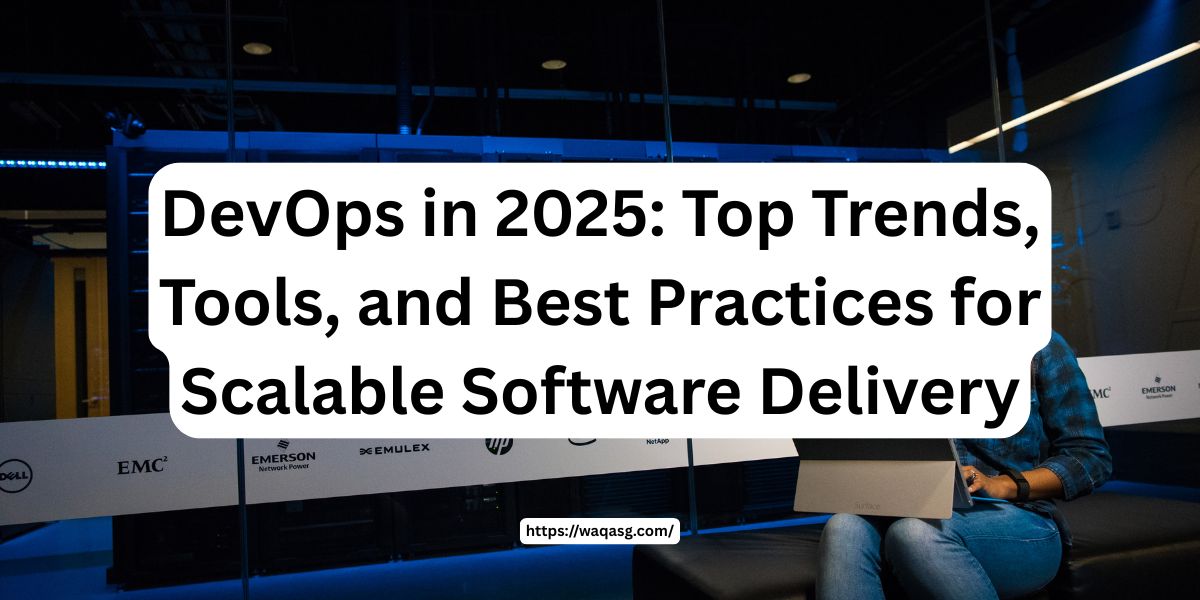
DevOps in 2025: Top Trends, Tools, and Best Practices for Scalable Software Delivery
Explore the future of DevOps in 2025 with the latest trends, essential tools, and actionable best practices. Learn how AIOps, DevSecOps, GitOps, and platform engineering are shaping modern software development.
Introduction: The Evolving DevOps Landscape
The term DevOps has come a long way since it first emerged over a decade ago. Initially seen as a cultural movement to break down silos between development and operations teams, DevOps has evolved into a comprehensive strategy that encompasses automation, collaboration, security, and scalability. By 2025, it’s clear that DevOps is no longer a “nice-to-have”—it’s mission-critical for organizations looking to thrive in a digital-first world.
Today’s software delivery demands speed, stability, and resilience. With increasing pressure to innovate and deploy faster while maintaining reliability, DevOps in 2025 is shaped by powerful trends like AI-driven automation, embedded security (DevSecOps), and the rise of platform engineering.
In this article, we’ll explore:
- The top DevOps trends in 2025
- The most impactful and widely adopted DevOps tools
- Key best practices for building sustainable DevOps pipelines
- Actionable insights to help you future-proof your organization’s software delivery approach
Part 1: Key DevOps Trends in 2025
1. AI-Powered DevOps (AIOps)
AI and machine learning are transforming DevOps in unprecedented ways. In 2025, AIOps is not just a futuristic concept—it’s embedded in CI/CD pipelines, observability stacks, and incident response systems. AIOps enables:
- Predictive incident detection and resolution
- Root cause analysis using anomaly detection
- Intelligent automation of repetitive tasks in infrastructure and deployments
For example, tools like Moogsoft, Dynatrace, and Harness AI are leading the charge by incorporating AI to enhance real-time performance monitoring, auto-remediation, and load balancing.
Keyword targets: AIOps, AI DevOps automation, machine learning in DevOps
2. DevSecOps: Security at Every Stage
Security continues to shift left in 2025. DevSecOps has become a default operating mode for many organizations, integrating security checks directly into development workflows. Teams now routinely:
- Run automated vulnerability scans on pull requests
- Enforce policy-as-code in CI/CD pipelines
- Monitor third-party dependencies in real time
DevSecOps ensures that secure code is the norm, not the exception. Open-source tools like Checkov, Trivy, and platforms like Snyk and Aqua Security are widely adopted in enterprise environments.
Keyword targets: DevSecOps, secure CI/CD, shift-left security, software supply chain security
3. Rise of Platform Engineering and IDPs
By 2025, platform engineering has emerged as a structured discipline focused on building Internal Developer Platforms (IDPs). These platforms abstract the complexity of infrastructure, giving developers easy access to resources while maintaining governance and scalability.
Benefits of IDPs include:
- Consistent, reusable infrastructure patterns
- Self-service environments for developers
- Built-in monitoring, logging, and deployment tools
Companies like Spotify and Zalando have publicly shared their success with platform engineering via tools like Backstage. Solutions like Humanitec and Port are making IDPs accessible even to smaller teams.
Keyword targets: platform engineering, internal developer platforms, developer productivity
4. GitOps for Automated Infrastructure Management
GitOps continues to gain traction as a preferred methodology for deploying applications and managing infrastructure using Git repositories as the source of truth. In 2025, GitOps is widely adopted due to:
- Declarative infrastructure using tools like Terraform, Crossplane, or Pulumi
- Automated, auditable deployments via ArgoCD or Flux
- Easy rollback and version control of infrastructure
GitOps makes Kubernetes-native environments more predictable and scalable, ideal for modern microservice architectures.
Keyword targets: GitOps CI/CD, GitOps Kubernetes, GitOps automation
5. Edge Computing and DevOps for IoT
With the proliferation of edge devices, 2025 demands DevOps workflows that support decentralized, remote environments. Teams are adapting CI/CD and observability practices for:
- Low-bandwidth or intermittent connectivity
- Hardware-constrained devices
- Remote software updates and rollbacks
Edge-native DevOps requires lightweight orchestration tools, container runtimes like K3s, and advanced monitoring using telemetry solutions like OpenTelemetry.
Keyword targets: edge DevOps, IoT DevOps, lightweight CI/CD
Part 2: The DevOps Toolchain for 2025
The DevOps toolchain in 2025 is diverse, integrated, and focused on automation, visibility, and security. Here are some of the top categories and leading tools:
CI/CD Tools
- GitHub Actions
- GitLab CI/CD
- CircleCI
- ArgoCD (for GitOps and Kubernetes deployments)
Infrastructure as Code (IaC)
- Terraform
- Pulumi
- Crossplane
- AWS CloudFormation
Containers & Orchestration
- Docker
- Kubernetes
- OpenShift
- Nomad (HashiCorp)
Observability & Monitoring
- Prometheus (metrics)
- Grafana (dashboards)
- Datadog (full-stack observability)
- OpenTelemetry (open standard for tracing/logging)
Security & Compliance
- Snyk (vulnerability scanning)
- Checkov (IaC scanning)
- Aqua Security
- HashiCorp Vault (secrets management)
Collaboration & Automation
- Slack (alerts and chatops)
- Jira (issue tracking)
- Ansible (config management)
- ServiceNow (ITSM integration)
Keyword targets: DevOps tools 2025, best CI/CD tools, infrastructure automation tools
Part 3: DevOps Best Practices in 2025
Technology alone doesn’t ensure success. DevOps is equally about people, culture, and process. Here are the most important best practices for thriving in 2025:
1. Shift Everything Left
From security to performance testing, early detection is key. Integrating these checks into the development cycle prevents expensive fixes down the road.
- Implement test automation at commit stage
- Use policy-as-code for compliance
- Integrate security scanners in your Git workflow
2. Prioritize Developer Experience
Developer productivity is now a strategic differentiator. Internal platforms should reduce friction, not add to it.
- Minimize cognitive load with streamlined workflows
- Provide intuitive, self-service tools
- Offer detailed feedback loops for testing and deployment
3. Build Observability In
Don’t bolt it on—design for observability from day one.
- Use OpenTelemetry for unified telemetry data
- Create dashboards that matter to both devs and ops
- Set up anomaly detection and alert tuning to avoid alert fatigue
4. Automate with Purpose
Not everything needs to be automated. Focus automation on tasks that are:
- Repetitive and time-consuming
- Prone to human error
- High-impact in terms of stability or speed
5. Promote a Culture of Continuous Improvement
DevOps thrives on collaboration, transparency, and accountability.
- Conduct regular retrospectives and postmortems
- Encourage cross-functional learning
- Break down silos with shared goals and KPIs
Final Thoughts: Is Your DevOps Future-Ready?
In 2025, DevOps success is defined by adaptability, intelligence, and security. As software complexity grows, the organizations that succeed will be those that embrace automation, streamline developer workflows, and embed security into every layer of the stack.
By staying aligned with these emerging DevOps trends, adopting the right tools, and committing to proven best practices, your team can accelerate delivery without sacrificing quality or security.
Whether you’re scaling up your current DevOps strategy or just beginning your journey, the future is bright for teams that build with purpose.
Want help choosing the right tools or building your internal developer platform?
Let me know, and I can help you design a strategy tailored to your team’s goals.





No comment yet, add your voice below!